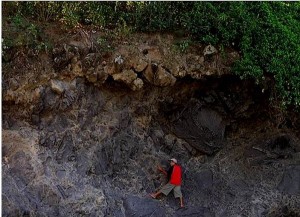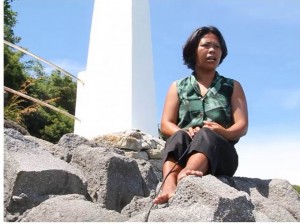
Going to school used to be an ordeal for the students residing in the island barangay of Macatunao in Concepcion, Iloilo. They had to negotiate the 3.6-kilometer stretch of stonewall clinging to the rough and spiky seawall to get to and from their school. Their mode of travel had become so infamous that the children have earned the moniker “Gagamba Kids (Spider Kids).”
Today, the students can travel safely to and from their barangay and school because the dangerous path they used to traverse now has a footbridge. What once was a danger zone has now become a tourist attraction, and the children need not be like spiders anymore.
The transformation of the community is partly due to the intervention of Kapit-Bisig Laban sa Kahirapan-Comprehensive and Integrated Delivery of Social Services (Kalahi-CIDSS), one of the core poverty reduction programs of the Department of Social Welfare and Development (DSWD). Through the cooperation of the residents, the local government unit, and Kalahi-CIDSS, the community now enjoys a barangay foot trail with footbridge.
Danger zone
Aside from the safety risks that the area posed to travelers, it also mounted problems to Barangay Macatunao. Three hundred children in the barangay are partner beneficiaries of the Pantawid Pamilyang Pilipino Program (Pantawid Pamilya), the flagship poverty alleviation program of the national government, implemented through the DSWD. While their situations may be different, all of them hope for the same thing: to be able to finish their education, get their diplomas, find jobs, and have better quality of lives for themselves and families.
Unfortunately, the difficulty in getting to and from the school presented a challenge to the families for several years. School children from Sitio Balabago had to climb a steep hill, creep across the nature-sculptured rocks, or brave the raging waters to reach Bagotao Primary School and Tambaliza National High School.
To avoid getting wet, they had to crawl on the rock wall for 360 meters until they reach the shoreline in Barangay Macatunao, hence they became known as “gagamba kids” in the village.
Fortunato Arlos Jr., 72 years old, recalled, in his younger days, how he would take that path in the morning and in the afternoon to get to Tambaliza Elementary School. In times when they got home late from school, they were forced to climb the mountain just to avoid the danger zone, which gets even more treacherous during high tide. He went on to share that he almost had a fatal accident while traversing the area while on his way to Fernando Arlos Elementary School in Barangay Tambaliza.
“Mga libro kag balonan ko basa, gakabit-kabit ako sa bato, maayo lang wala ako nabatian (My books and lunch box were drenched in water, I was clinging on the stone. I was lucky I did not break a bone),” he narrated.
The problem of traveling from one part of the barangay to another has existed for so long that almost all who grew up in the village earned the dubious distinction of being a “gagamba kid” at some point in their lives.
The story of Vivian and the villagers

Like everyone else in the village, Vivian Dolor says she was once a “spider girl” in her teenage years. She and her friends would cling to the cliff wall just to get to Bagotao Primary School. It was her routine until she completed her elementary education.
Vivian, now 42, described how the edges of the stones near the site of the foot bridge were very sharp. “Makita mo sa iban nga lugar may mga bata man pero diri pinasahi. Kon tapakan mo mabiak imo dapa-dapa kon wala ka tsinelas. Delikado pa kay may sakaon sa bukid. May madalum man nga portion nga kon high tide mas madalum (There are stones in other areas, but ours is different. You will get cuts if you step on these without wearing your slippers. It is also dangerous because you needed to climb the mountain. There is also a deep part, which gets even deeper during high tide),” she narrated.
After finishing elementary and high school, Vivian went on to take a vocational course at the Computer College of the Visayas in Iloilo City. She subsequently worked as an Overseas Filipino Worker (OFW) in Hongkong to help her siblings and parents.
She later returned to Concepcion to stay for good, establishing a family in the process.
Vivian became involved in KALAHI-CIDSS in 2010 when she thought of helping the community by volunteering in the Project. She was eventually chosen by the community to become the Barangay Sub-Project Management Committee (BSPMC) chair, the head of community volunteers in Kalahi-CIDSS.
Vivian vividly recalled the events that happened on October 14, 2010, when she and Ramie Padecio, another volunteer, went to the town for the two-day Municipal Inter-Barangay Forum (MIBF), one of the activities in KALAHI-CIDSS wherein residents in the municipality voted for which of the barangays’ proposed community projects will receive funding from the Project. The typhoons that raged then did not stop them from going to the town to try to get their proposed foot path and bridge, which was identified by Barangay Macatunao as their priority community project.
Before the MIBF, Vivian and Ramie almost lost hope that they would be able to get their proposed foot path and bridge when they found out they needed to have photos of the site, as they did not have the money to get these printed. Vivian recalled being told that their chance of getting their proposed community project prioritized might fail if they did not have the pictures with them.
Determined to solve the problem, Vivian took off her wedding ring and pawned it. She used the P500.00 to develop photos and prepare other materials for their barangay’s presentation. Ramie, a school teacher at the Tambaliza National High School, gave the presentation in behalf of their barangay.
Apparently, their sacrifices and efforts paid off when the proposed foot trail and bridge project amounting to P1.58 million was voted as one of the projects to receive funding from Kalahi-CIDSS.
Other villagers like Fortunato, recalling his near-fatal accident when he was once a “gagamba kid” and the daily sight he witnessed from his window of children clinging to the seawall to get to school encouraged him to donate 200 meters of his property for the foot trail.
Fortunato stated, “Nga-a indi ka abi mag donar kay nakita mo nga mabudlay ang pag-agi. Kita mo gakalumos mga kabataan nga gatabok pakadto sa eskwelahan kay ang alagyan sang mga bata kundi pati man mga tigulang? (Why wouldn’t you help, when you can see that the path is very difficult, and you know children risk of drowning every time they pass the shoreline to go to school?).” Other villagers also contributed portion of their daily wages as part of their village’s local counterpart contribution for their sub-project.
Residents of Macatunao would never forget how the government hugely transformed their lives. They were so thankful to the government and to the community’s combined efforts for they were finally able to get their foot path and bridge. Young and old folks alike are now able to pass through the area any time of the day, be it high tide or low tide.
Project, volunteers recognized
The sub-project was first featured in the Philippine Daily Inquirer on July 30, 2011, highlighting the story of the “spider kids” and the personal sacrifices of Vivian.
The story was then picked up by Rated K, which featured Vivian’s selflessness on its March 4, 2012 episode “Singsing for Schooling.”
Rated K was supposed to redeem the wedding ring as a surprise for Vivian during her interview in Manila. Since the television staff could not redeem the wedding ring without the receipt, the help of Mayor Milliard Villanueva was sought. Familiar with Vivian’s selfless deeds, the pawnshop returned the wedding ring without any monetary consideration.
After more than a year, Vivian was able to get back her wedding ring through the program.
The “Singsing for Schooling” episode subsequently caught the attention of Rotary International 3790 (RI 3790) in Angeles, Pampanga. They invited Vivian to their District Assembly so she can share her inspiring story. A cash gift was given to Vivian by RI 3790, which also shouldered her transportation expenses and provided an allowance to her husband and her son while she was away. The Rotary International also donated flying discs for the village children of Barangay Macatunao.
Added opportunities
Although the construction of the foot bridge was identified by the villagers for utilitarian purposes so they can travel easily from Sitio Bagotao to Sitio Balabago and vice versa, the residents were pleased that it brought other benefits to their community, including the making of the former danger zone a tourist attraction.
Though the local government unit has yet to account for all the visitors in the island, the residents themselves attest that tourists recognized the tourism potential of the area.
The panoramic scenery of shifting emerald waters and nature-sculptured rocks regularly draw tourists. The main attraction of the area, however is the lumpatan. In Hiligaynon, “lumpatan” means a place where to jump. In this instance, the lumpatan, which is located at the end portion of the foot bridge, is used as dive-off point for those who want to try cliff jumping.
A distance away from the lumpatan is a drawing of two turtles etched on the stone-wall, previously not appreciated by travelers going from Sitio Balabago to Sitio Bagotao, since they were more concerned about getting safely to their destination instead of sightseeing. The construction of the foot bridge allowed visitors to appreciate this, as well as other attractions, including sculptured rocks, which resemble the mouth of a lion, and boulders that look like a log with tables.
The construction of the footbridge through KALAHI-CIDSS also opened opportunities for villagers to start small businesses. Due to the influx of tourists, some of the residents now earn extra income by selling native delicacies to the visitors and fellow villagers.
The spirit of bayanihan and volunteerism is alive and well in Barangay Macatunao. They are now reaping the fruits of their hard work and perseverance. ###


